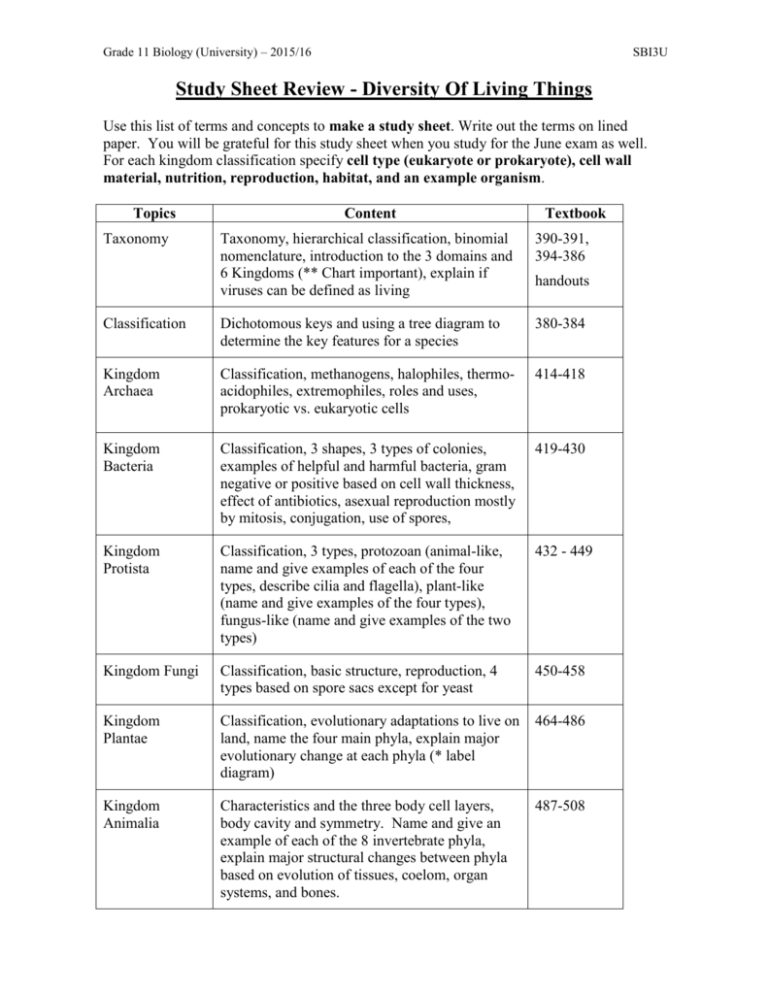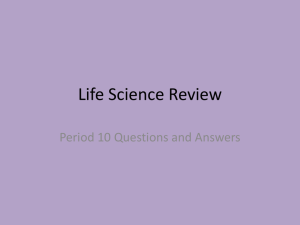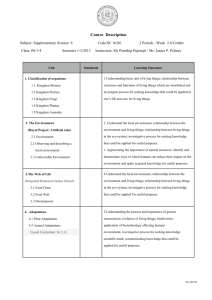Taxonomy Unit Test Review - rosedale11universitybiology
advertisement

Grade 11 Biology (University) – 2015/16 SBI3U Study Sheet Review - Diversity Of Living Things Use this list of terms and concepts to make a study sheet. Write out the terms on lined paper. You will be grateful for this study sheet when you study for the June exam as well. For each kingdom classification specify cell type (eukaryote or prokaryote), cell wall material, nutrition, reproduction, habitat, and an example organism. Topics Taxonomy Content Textbook Taxonomy, hierarchical classification, binomial nomenclature, introduction to the 3 domains and 6 Kingdoms (** Chart important), explain if viruses can be defined as living 390-391, 394-386 Classification Dichotomous keys and using a tree diagram to determine the key features for a species 380-384 Kingdom Archaea Classification, methanogens, halophiles, thermoacidophiles, extremophiles, roles and uses, prokaryotic vs. eukaryotic cells 414-418 Kingdom Bacteria Classification, 3 shapes, 3 types of colonies, examples of helpful and harmful bacteria, gram negative or positive based on cell wall thickness, effect of antibiotics, asexual reproduction mostly by mitosis, conjugation, use of spores, 419-430 Kingdom Protista Classification, 3 types, protozoan (animal-like, name and give examples of each of the four types, describe cilia and flagella), plant-like (name and give examples of the four types), fungus-like (name and give examples of the two types) 432 - 449 Kingdom Fungi Classification, basic structure, reproduction, 4 types based on spore sacs except for yeast 450-458 Kingdom Plantae Classification, evolutionary adaptations to live on land, name the four main phyla, explain major evolutionary change at each phyla (* label diagram) 464-486 Kingdom Animalia Characteristics and the three body cell layers, body cavity and symmetry. Name and give an example of each of the 8 invertebrate phyla, explain major structural changes between phyla based on evolution of tissues, coelom, organ systems, and bones. 487-508 handouts Grade 11 Biology (University) – 2015/16 SBI3U Taxonomy Unit Test Outline The test will be about 65 marks divided as follows: 15-20 marks multiple choice 10-15 marks matching 6-10 marks diagrams 20 marks short answers 5 marks inquiry/ thinking At least 5 marks will be taken from each of the topics listed in the study sheet review. Help is available from Ms. Kopplin at lunch on Day 2 or from Ms Murray, in Rm. 205, the first 20 minutes of lunch or after school, or anytime by appointment. After making a study sheet, test yourself by doing these practice questions: Text p 514 # 1 – 15, 17, 19-22, 23-27, 29-32, 33-36, 42-46,51 There will be review practice questions during the review classes on Thursday Jan 14, and Fri Jan 15. If you have completed your study sheet you can use this to try the review questions. Here are a few “warm-up questions”. Matching 1. Animal Structures A ___ inner body layer that consists of internal organs ___ Outer body layer that consists of skin and nerves ___ body plan of a human ___ body plan of a sea urchin ___ middle body layer that consists of muscles and blood ___ fluid-filled body cavity B a. coelom b. mesoderm c. radial d. ectoderm e. endoderm f. bilateral 2. Classifying Invertebrates A ___ ___ ___ ___ ___ ___ Soft-bodied organisms with an external shell Simplest animals, lack tissues and organs Examples include jellyfishes and corals Have long, thin, round worm like bodies Includes spiders, centipedes, crabs and insects Have a spiny outer covering for protection B a. Nematodes b. Arthropods c. Echinoderms d. Cnidarians e. Porifera f. Mollusca










